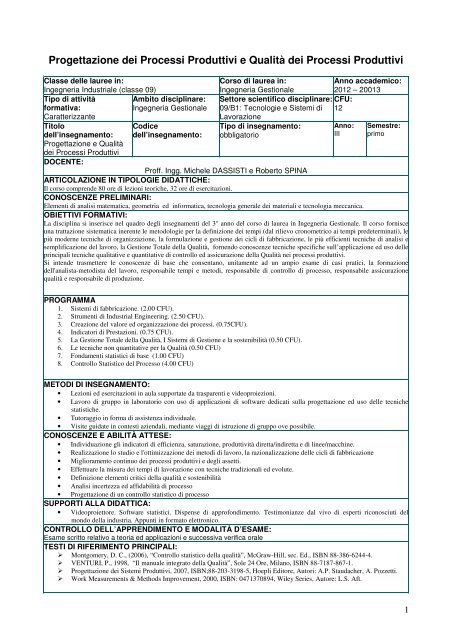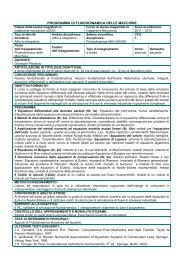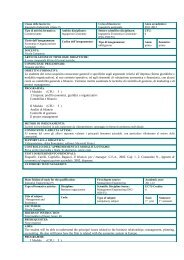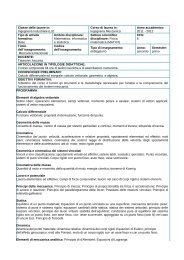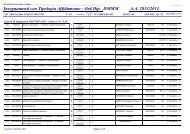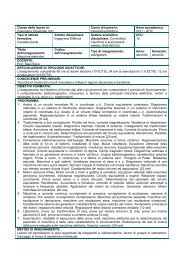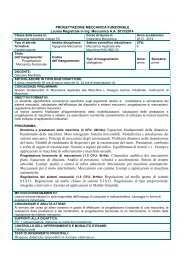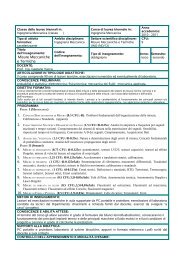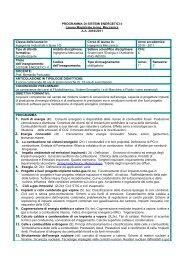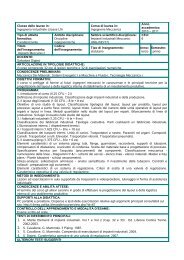Spina, Dassisti - Politecnico di Bari
Spina, Dassisti - Politecnico di Bari
Spina, Dassisti - Politecnico di Bari
You also want an ePaper? Increase the reach of your titles
YUMPU automatically turns print PDFs into web optimized ePapers that Google loves.
Progettazione dei Processi Produttivi e Qualità dei Processi ProduttiviClasse delle lauree in:Ingegneria Industriale (classe 09)Tipo <strong>di</strong> attivitàformativa:CaratterizzanteTitolodell’insegnamento:Progettazione e Qualitàdei Processi ProduttiviAmbito <strong>di</strong>sciplinare:Ingegneria GestionaleCo<strong>di</strong>cedell’insegnamento:Corso <strong>di</strong> laurea in:Ingegneria GestionaleAnno accademico:2012 – 20013Settore scientifico <strong>di</strong>sciplinare: CFU:09/B1: Tecnologie e Sistemi <strong>di</strong> 12LavorazioneTipo <strong>di</strong> insegnamento: Anno: Semestre:obbligatorioIII primoDOCENTE:Proff. Ingg. Michele DASSISTI e Roberto SPINAARTICOLAZIONE IN TIPOLOGIE DIDATTICHE:Il corso comprende 80 ore <strong>di</strong> lezioni teoriche, 32 ore <strong>di</strong> esercitazioni.CONOSCENZE PRELIMINARI:Elementi <strong>di</strong> analisi matematica, geometria ed informatica, tecnologia generale dei materiali e tecnologia meccanica.OBIETTIVI FORMATIVI:La <strong>di</strong>sciplina si inserisce nel quadro degli insegnamenti del 3° anno del corso <strong>di</strong> laurea in Ingegneria Gestionale. Il corso fornisceuna trattazione sistematica inerente le metodologie per la definizione dei tempi (dal rilievo cronometrico ai tempi predeterminati), lepiù moderne tecniche <strong>di</strong> organizzazione, la formulazione e gestione dei cicli <strong>di</strong> fabbricazione, le più efficienti tecniche <strong>di</strong> analisi esemplificazione del lavoro, la Gestione Totale della Qualità, fornendo conoscenze tecniche specifiche sull’applicazione ed uso delleprincipali tecniche qualitative e quantitative <strong>di</strong> controllo ed assicurazione della Qualità nei processi produttivi.Si intende trasmettere le conoscenze <strong>di</strong> base che consentano, unitamente ad un ampio esame <strong>di</strong> casi pratici, la formazionedell'analista-meto<strong>di</strong>sta del lavoro, responsabile tempi e meto<strong>di</strong>, responsabile <strong>di</strong> controllo <strong>di</strong> processo, responsabile assicurazionequalità e responsabile <strong>di</strong> produzione.PROGRAMMA1. Sistemi <strong>di</strong> fabbricazione. (2.00 CFU).2. Strumenti <strong>di</strong> Industrial Engineering. (2.50 CFU).3. Creazione del valore ed organizzazione dei processi. (0.75CFU).4. In<strong>di</strong>catori <strong>di</strong> Prestazioni. (0.75 CFU).5. La Gestione Totale della Qualità, I Sistemi <strong>di</strong> Gestione e la sostenibilità (0.50 CFU).6. Le tecniche non quantitative per la Qualità (0.50 CFU)7. Fondamenti statistici <strong>di</strong> base (1.00 CFU)8. Controllo Statistico del Processo (4.00 CFU)METODI DI INSEGNAMENTO:• Lezioni ed esercitazioni in aula supportate da trasparenti e videoproiezioni.• Lavoro <strong>di</strong> gruppo in laboratorio con uso <strong>di</strong> applicazioni <strong>di</strong> software de<strong>di</strong>cati sulla progettazione ed uso delle tecnichestatistiche.• Tutoraggio in forma <strong>di</strong> assistenza in<strong>di</strong>viduale.• Visite guidate in contesti aziendali, me<strong>di</strong>ante viaggi <strong>di</strong> istruzione <strong>di</strong> gruppo ove possibile.CONOSCENZE E ABILITÀ ATTESE:• In<strong>di</strong>viduazione gli in<strong>di</strong>catori <strong>di</strong> efficienza, saturazione, produttività <strong>di</strong>retta/in<strong>di</strong>retta e <strong>di</strong> linee/macchine.• Realizzazione lo stu<strong>di</strong>o e l'ottimizzazione dei meto<strong>di</strong> <strong>di</strong> lavoro, la razionalizzazione delle cicli <strong>di</strong> fabbricazione• Miglioramento continuo dei processi produttivi e degli assetti.• Effettuare la misura dei tempi <strong>di</strong> lavorazione con tecniche tra<strong>di</strong>zionali ed evolute.• Definizione elementi critici della qualità e sostenibilità• Analisi incertezza ed affidabilità <strong>di</strong> processo• Progettazione <strong>di</strong> un controllo statistico <strong>di</strong> processoSUPPORTI ALLA DIDATTICA:• Videoproiettore. Software statistici. Dispense <strong>di</strong> approfon<strong>di</strong>mento. Testimonianze dal vivo <strong>di</strong> esperti riconosciuti delmondo della industria. Appunti in formato elettronico.CONTROLLO DELL’APPRENDIMENTO E MODALITÀ D’ESAME:Esame scritto relativo a teoria ed applicazioni e successiva verifica oraleTESTI DI RIFERIMENTO PRINCIPALI: Montgomery, D. C., (2006), “Controllo statistico della qualità”, McGraw-Hill, sec. Ed., ISBN 88-386-6244-4. VENTURI, P., 1998, “Il manuale integrato della Qualità”, Sole 24 Ore, Milano, ISBN 88-7187-867-1. Progettazione dei Sistemi Produttivi, 2007, ISBN;88-203-3198-5, Hoepli E<strong>di</strong>tore, Autori: A.P. Staudacher, A. Pozzetti. Work Measurements & Methods Improvement, 2000, ISBN: 0471370894, Wiley Series, Autore: L.S. Aft.1
ULTERIORI TESTI SUGGERITI: DASSISTI M., 2002, Le nuove frontiere della qualità sostenibile, <strong>Politecnico</strong> <strong>di</strong> <strong>Bari</strong>, Minervini (Molfetta), ISBN 88-900637-1-8. FRANCESCHINI, F.; 1998; Quality Function Deployment; sole 24ore, Milano; ISBN 88-7187-861-2 MUNRO-FAURE, L, MUNRO-FAURE, M, 1994, “Qualità Totale: tecniche <strong>di</strong> attuazione”, Jackson, Trento DASSISTI M., MELPIGNANO, G., 2006, Progetto Grafibench: Il benchmarking per la costituzione <strong>di</strong> un polo <strong>di</strong>eccellenza delle aziende grafiche, Centro orientamento RADAR, <strong>Bari</strong>. UNI EN ISO 9001, 2008, “Sistemi <strong>di</strong> gestione della Qualità: requisiti””, UNI, Milano. VICARIO, G., LEVI, R., 1997, “Calcolo delle Probabilità e statistica per ingegneri”, Progetto Leonardo, Bologna, , ISBN88-86524-16-1.Associazione Premio Qualità Italia; 2002; “Guida alla partecipazione ed alla autovalutazione-livello nazionale”; Piazza delPozzetto, 9 – Pisa SCIUCCATI, F.M., TANAKA, M.; 1994, “Riprogettare il sistema <strong>di</strong> produzione”, Il Sole 24 Ore, Milano, ISBN 88-7187-457-9.DECLARATORIA1. Sistemi <strong>di</strong> fabbricazione. (2.00 CFU)Introduzione. Principali tipi <strong>di</strong> classificazione Classificazione composita, <strong>di</strong> Wortmann ed impiantistica. Modello <strong>di</strong> un sistemamanifatturiero. Job shop. Linea transfer. Celle <strong>di</strong> fabbricazione. Casi Aziendali.2. Strumenti <strong>di</strong> Industrial Engineering. (2.50 CFU)Gli utilizzi dei cicli <strong>di</strong> fabbricazioni. Il legame tra dati <strong>di</strong> prodotto e dati <strong>di</strong> processo. Il contenuto informativo dei cicli <strong>di</strong>fabbricazione (e degli archivi <strong>di</strong> produzione). I criteri per la sud<strong>di</strong>visione dei cicli in fasi e per la strutturazione dei cicli <strong>di</strong>produzione. La gestione dei cicli alternativi e delle fasi alternative. La gestione delle fasi batch. La determinazione dei tempi <strong>di</strong>lavorazione. Le tecniche <strong>di</strong> tempificazione delle operazioni (MTM, work sampling,…). La manutenzione dei tempi ciclo. Le gestioneintegrata delle informazioni <strong>di</strong> fabbricazione. Istruzioni <strong>di</strong> fabbricazione. Istruzioni <strong>di</strong> collaudo. Schede macchina. Schedeattrezzature.3. Creazione del valore ed organizzazione dei processi. (0.75CFU)Concetti fondamentali. Il valore della progettazione e dell’industrializzazione. Il valore del processo produttivo. La struttura deiprocessi. La rappresentazione dei processi.4. In<strong>di</strong>catori <strong>di</strong> Prestazioni. (0.75 CFU)Generalità. Fattori connessi ai Costi, Volumi, Tempi e Qualità. Dimensioni del miglioramento per Prodotto, Componenti funzionali eprocesso. Tempi e Meto<strong>di</strong>. Analisi dei Processi. Tipi <strong>di</strong> flusso e <strong>di</strong> processo. Riduzione dei tempi <strong>di</strong> attraversamento. Selezione delprocesso. Progettazione dei flussi.5. La Gestione Totale della Qualità, I Sistemi <strong>di</strong> Gestione e la sostenibilità (0.50 CFU)Il concetto <strong>di</strong> qualità e sostenibilità. I costi della qualità. Gli elementi del Total Quality Management. La gestione per processi.L’approccio Sei Sigma. Sistema <strong>di</strong> Gestione Qualità: aspetti normativi e la certificazione <strong>di</strong> sistema. Sistema <strong>di</strong> Gestione integratoQualità, Ambiente e Sicurezza; Life Cycle Assessment. Il self-assessment.6. Le tecniche non quantitative per la Qualità (0.50 CFU)Strumenti per il problem-solving (brainstorming; <strong>di</strong>agramma <strong>di</strong> Pareto; <strong>di</strong>agramma <strong>di</strong> Ishikawa; analisi dei campi <strong>di</strong> forza;<strong>di</strong>agrammi <strong>di</strong> <strong>di</strong>spersione, <strong>di</strong>agrammi <strong>di</strong> concentrazione dei <strong>di</strong>fetti). Meto<strong>di</strong> grafici <strong>di</strong> raccolta dati. Misure descrittive dei dati.Quality Function Deployment. Benchmarking.7. Fondamenti statistici <strong>di</strong> base (1.00 CFU)Il concetto <strong>di</strong> probabilità. Probabilità con<strong>di</strong>zionata. Teorema probabilità totali. Formula <strong>di</strong> Bayes. Regole delle probabilità.In<strong>di</strong>pendenza stocastica. Le variabili aleatorie <strong>di</strong>screte e continue. Funzione <strong>di</strong>stribuzione cumulata. Funzioni densità <strong>di</strong> probabilità<strong>di</strong>screte e continue. Disuguaglianza <strong>di</strong> Chebysheff. Momenti; me<strong>di</strong>a e varianza. Distribuzioni <strong>di</strong> 1 v.a. <strong>di</strong>screte e continue.Distribuzioni campionarie. Legge dei gran<strong>di</strong> numeri. Teorema centrale del limite. L’inferenza statistica. Test <strong>di</strong> ipotesi. Le carte <strong>di</strong>probabilità.8. Controllo Statistico del Processo (3.50 CFU)Variabilità. Campionamento. Affidabilità. Controllo statistico <strong>di</strong> processo con dati non correlati e correlati. Concetti applicativigenerali sulle carte <strong>di</strong> controllo. Progettazione <strong>di</strong> carte <strong>di</strong> controllo. Carte <strong>di</strong> controllo della me<strong>di</strong>a e del range. Carte <strong>di</strong> controllodella me<strong>di</strong>a e della deviazione standard campionaria. Carte <strong>di</strong> controllo per attributi del tipo per frazione <strong>di</strong> non conformi e del tipoper numero <strong>di</strong> non conformità. Analisi <strong>di</strong> capacità <strong>di</strong> processo. Stu<strong>di</strong> <strong>di</strong> capacità <strong>di</strong> strumenti e sistemi <strong>di</strong> misura. Carte a me<strong>di</strong>amobile. Carte <strong>di</strong> controllo per produzioni <strong>di</strong> breve durata. Carte CUSUM. Carte EWMA. Scelta delle carte <strong>di</strong> controllo. Progettazioneeconomica delle carte <strong>di</strong> controllo.2
Design of Production Processes and Quality of Production ProcessesMain field(s) of study for the qualification:Industrial engineering (09)Type of formative Discipline:activity:managementCharacteristic subject engineeringTitle of subject:Design and Quality ofProduction ProcessesCo<strong>di</strong>cedell’insegnamento:First degree course:Management engineeringScientific Discipline Sector:09/B1: Production Systems andTechnologiesType of subject:compulsory subjectAcademic year:2012 – 20013ECTS Cre<strong>di</strong>ts:12Year:3rd yearSemester:1 st semesterLECTURERS:Michele DASSISTI and Roberto SPINAHOURS OF INSTRUCTIONTotal number of hours: 112. Theory: 80 hours. Numerical applications: 32 hours.PREREQUISITES:Maths, Geometry, Informatics, Material Technologies, Mechanical TechnologyOBIETTIVI FORMATIVI:Class provides systematic frame of methodologies for production time definition, production organisation, definition andmanagement of production cycles, analysis of craftsmanship labor, Total Quality Management provi<strong>di</strong>ng a corpus of knowledge onqualitative and quantitative techniques for manufacturing process quality assurance.Class assures students the capability to manage production cycle, to control production processes and to guarantee qualityassurance.PROGRAMMA1. Manufacturing systems. (2.00 cre<strong>di</strong>ts)2. Industrial Engineering tools. (2.50 cre<strong>di</strong>ts)3. Value creation and organization processes. (0.75 cre<strong>di</strong>ts)4. Performance In<strong>di</strong>cators. (0.75 cre<strong>di</strong>ts)5. Total Quality Management, Management Systems and sustainability (0.5 cre<strong>di</strong>ts).6. Non-quantitative methods for Quality assurance (0.50 cre<strong>di</strong>ts)7. Basic statistics (1.00 cre<strong>di</strong>ts)8. Statistical Process Control (4.00 cre<strong>di</strong>ts)TEACHING METHODS: Class lectures, supported by transparencies and video-projections. Labs and workgroups using statistical softwares. In<strong>di</strong>vidual coaching. Guided visits on real manufacturing settings.EXPECTED KNOWLEDGES AND SKILLS:9. Identifying the in<strong>di</strong>cators of efficiency, saturation, productivity, <strong>di</strong>rect / in<strong>di</strong>rect and lines / machines.10. Implementation study and optimization of working methods, the rationalization of manufacturingcycles11. Continuous improvement of production processes and organisations12. Measurement of working time with tra<strong>di</strong>tional and advanced techniques.ù13. Defining critical elements of quality and sustainability14. Analysis and process reliability and uncertainty15. Design of a statistical process controlTEACHING AIDS:Video-projector. Software’s for quality control. Didactical notes. Industrial expert live-testimonials. Notefromteacher.EXAMINATION METHOD:Numerical tests on topics concerning with a final oral <strong>di</strong>scussion aimed at evaluating the systemiccomprehension of the whole subjects.3
BIBLIOGRAPHY: Montgomery, D. C., (2006), “Controllo statistico della qualità”, McGraw-Hill, sec. Ed., ISBN 88-386-6244-4. VENTURI, P., 1998, “Il manuale integrato della Qualità”, Sole 24 Ore, Milano, ISBN 88-7187-867-1. Progettazione dei Sistemi Produttivi, 2007, ISBN;88-203-3198-5, Hoepli E<strong>di</strong>tore, Autori: A.P. Staudacher, A.Pozzetti. Work Measurements & Methods Improvement, 2000, ISBN: 0471370894, Wiley Series, Autore: L.S. Aft.FURTHER READINGS:• DASSISTI M., 2002, Le nuove frontiere della qualità sostenibile, <strong>Politecnico</strong> <strong>di</strong> <strong>Bari</strong>, Minervini (Molfetta), ISBN88-900637-1-8.• FRANCESCHINI, F.; 1998; Quality Function Deployment; sole 24ore, Milano; ISBN 88-7187-861-2• MUNRO-FAURE, L, MUNRO-FAURE, M, 1994, “Qualità Totale: tecniche <strong>di</strong> attuazione”, Jackson, Trento• DASSISTI M., MELPIGNANO, G., 2006, Progetto Grafibench: Il benchmarking per la costituzione <strong>di</strong> un polo <strong>di</strong>eccellenza delle aziende grafiche, Centro orientamento RADAR, <strong>Bari</strong>.• UNI EN ISO 9001, 2008, “Sistemi <strong>di</strong> gestione della Qualità: requisiti””, UNI, Milano.• VICARIO, G., LEVI, R., 1997, “Calcolo delle Probabilità e statistica per ingegneri”, Progetto Leonardo, Bologna,, ISBN 88-86524-16-1.• Associazione Premio Qualità Italia; 2002; “Guida alla partecipazione ed alla autovalutazione-livello nazionale”;Piazza del Pozzetto, 9 – Pisa• SCIUCCATI, F.M., TANAKA, M.; 1994, “Riprogettare il sistema <strong>di</strong> produzione”, Il Sole 24 Ore, Milano, ISBN88-7187-457-9.DETAILED PROGRAM1. Manufacturing systems. (2.00 cre<strong>di</strong>ts)Introduction. Classification classification of manufacturing systems. Manufacturing system model. Job shop. Transfer line.Manufacturing cells. Case Stu<strong>di</strong>es.2. Industrial Engineering tools. (2.50 cre<strong>di</strong>ts)The use of the manufacturing cycle. The link between product data and process data. The information content of the cycles ofproduction (and production files). The criteria for the <strong>di</strong>stribution of phases and cycles in the structuring of production cycles. Cyclemanagement and alternative options stage. The management of batch phases. The determination of processing times. The techniquesof timing of operations (MTM, work sampling, ...). Maintenance cycle time. The integrated management of manufacturinginformation. Manufacturing instructions. Instructions for testing. Machine cards. Equipment cards.3. Value creation and organization processes. (0.75CFU)Basic concepts. The value of the design and industrialization. The value of the production process. The structure of the processes.The representation of the process.4. Performance In<strong>di</strong>cators. (0.75 cre<strong>di</strong>ts)Generalities. Factors related to cost, volume, time and quality. Dimensions of product improvement, functional components andprocess. Timing and Methods. Process Analysis. Types and process flow. Reduction of lead times. Selection process. Design flows.5. Total Quality Management, Management Systems and sustainability (0.5 Cre<strong>di</strong>ts)The concept of Quality. Technical terms for quality engineering. Quality costs. Total Quality Management (TQM). Processmanagement. Continuous process improvement. Six Sigma. Quality Management Systems: norms and their certification. IntegratedManagement Systems for Quality, Environment and Safety; life cycle assessment. Quality Awards and self-assessment.6. Non-quantitative methods for Quality assurance (0,5 Cre<strong>di</strong>ts)Problem-solving tools (brainstorming; Pareto <strong>di</strong>agram; Ishikawa <strong>di</strong>agram; force field method; <strong>di</strong>spersion <strong>di</strong>agram, defectconcentration <strong>di</strong>agram). Graphical methods for data collection. Descriptive tools for data. Quality Function Deployment.Benchmarking.7. Basic statistics (1 Cre<strong>di</strong>ts)Probability. Con<strong>di</strong>tional Probability. Total probability theorem. Bayes theorem. Probability rules. Stochastic independence. Discreteand continue stochastic variables. Cumulative <strong>di</strong>stribution function. Discrete and continue probability density functions (p.d.f.).Tchebycheff inequality. Moments; mean and variance. P.d.f. of one stochastic variable <strong>di</strong>screte (binomial , hypergeometric ,Poisson, Pascal) and continue (normal, lognormal, exponential, gamma, Weibull). Sample <strong>di</strong>stribution. Large number law. Centrallimit theorem. Statistical inference. Hypothesis testing. Probability charts.8. Statistical Process Control (3,5 Cre<strong>di</strong>ts)Statistical process control with uncorrelated data(SPC). Variability. Sampling. Engineering and statistic process control. SPC withcorrelated data. General concepts on control charts. Control limits selections. Trends in control charts. Control charts of mean andrange. Control charts of mean and range and standard deviations. Control charts for attributes: type fraction of non conforming and4
type of number of non-conforming entities. Process capability analysis. Capability stu<strong>di</strong>es of measurement systems. Movingaverage charts. Control charts for short-run. CUSUM. EWMA. Control charts selection. Economic design of control charts.5


